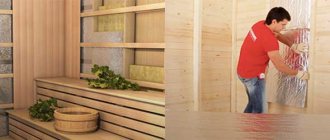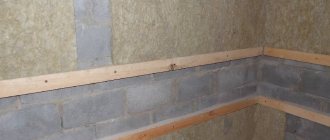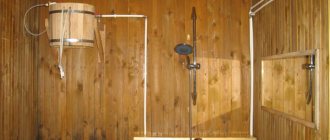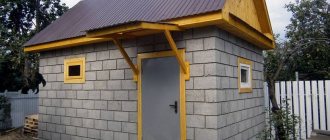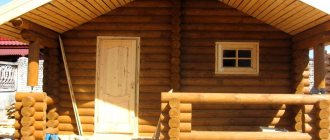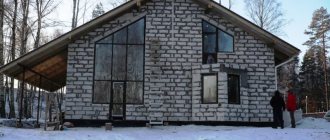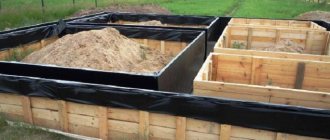The Russian bathhouse is still made of wood, but replaced the log house technologically more advanced designs:
- log house made of rounded logs;
- log house made of timber (glued or profiled).
If the thickness of the logs of a Russian bathhouse in the old days allowed for insulation of only the space between the crowns, then the less powerful body of a rounded log, and even more so, a beam, requires complex work to insulate the structure , intended for use in any season of the year.
The bathhouse must comply with the principle of a thermos - to retain heat at any external temperature. In this regard, the significance of the design solutions of the project is significant: according to the method of connecting wooden elements when knitting crowns, according to the location of the steam room relative to the soap room and dressing room, the height and thickness of the windows, the size of doorways, the height of the thresholds, and the design of the “heater”.
But we cannot detract from the system of measures for insulating external walls, floors and ceilings, and the technological features of this process in different rooms of the bathhouse.
What materials are best to use for insulation?
Today, you can find a huge number of different types of insulation on the market, which is why many novice bathhouse attendants face big problems when choosing. It is strictly forbidden to use polystyrene foam and its analogues, since this material is very flammable and also does not allow air to pass through, so during steam procedures, moisture will form on the wood and it will begin to rot over time.
There is no fundamental difference when choosing insulation; you can use any modern material that has high vapor permeability. One of these is mineral wool.
An excellent option for insulating a shower room is flax fiber.
However, it is worth remembering that when heated, it begins to emit substances harmful to human health, so it can only be used for external insulation. To insulate a steam room from the inside, basalt wool or ecowool, which does not have any impregnation and does not ignite at high temperatures, is perfect.
To insulate a shower room, flax fiber and soft fiberboard are an excellent option. These are modern materials that have excellent vapor permeability, as well as a good ability to absorb and release moisture, so that condensation will not form between the timber and the insulation layer, and the wood will not be subject to rotting processes.
As for the use of foil, everything is ambiguous here, since some bathhouse attendants consider it mandatory when insulating a bathhouse, while others do not. If you like higher temperatures during steam procedures and tougher steams, then it will not be superfluous. However, when laying it you must be very careful, since even the slightest mistake can lead to the formation of fungi and rot.
How to insulate a dressing room from the inside with your own hands
Errors in insulation will lead to rapid cooling of the bath. Therefore, the question of whether it is necessary to insulate the floor in the dressing room, doors, walls and ceiling should disappear. A waiting room without ventilation will be humid, all wooden structures will quickly become covered with fungus and mold, and an unpleasant odor will appear in the room. All this will not contribute to rest and relaxation after taking procedures in the steam room.
How to insulate a door in a dressing room
Photo. Thermal insulation of the door in the dressing room
Without an insulated entrance door, all work on thermal insulation of this room will not give the desired effect. All the heat will escape through the door leaf and the cracks of the doorway in winter. Meanwhile, it is not difficult to insulate a door - we talked about this in the material How to insulate a steam room door. To work, you will need a minimum set of tools, as well as self-tapping screws, an antiseptic for wood processing, timber, insulation and a sheet of plywood.
A beam with a cross-section equal to the thickness of the insulation is placed on the perimeter of the dressing room door. Insulation is laid between the bars of this frame, and the structure is sheathed on top with a sheet of plywood or OSB. If URSA mineral wool is used as thermal insulation, it must be covered with rolled waterproofing on all sides. When using slab insulation, all cracks and seams should be sealed with foam.
The second common way to insulate a dressing room door with your own hands is to install a second door indoors. In a situation where it is impossible to insulate the dressing room door yourself or it has already exhausted its resource, you should replace the door with a new one. For a dressing room, it is better to choose a two-chamber door, inside of which there is thermal insulation (for streets it is preferable to choose a door with polyurethane foam).
How to insulate the floor in a dressing room
Photo. Do-it-yourself insulation of the waiting room floor
In addition to insulating the door, you should consider thermal insulation of the floor, walls and ceiling of the dressing room. Please note that there will be high humidity in the room and especially often water gets on the floor in the dressing room. All these factors can cause rapid rotting of the floor boards, so the floor must be treated with antiseptics or liquid waterproofing. This rule also applies to other wooden surfaces in any room.
Do-it-yourself insulation of the floor in the dressing room is done using the technology of thermal insulation of a wooden floor along joists. To do this, a layer of thermal insulation is laid on the subfloor between the joists and covered with moisture-resistant OSB boards. If you used mineral wool to insulate the floor, it should be covered with a vapor barrier film so that the material does not absorb moisture. Expanded polystyrene does not need additional vapor barrier.
How to insulate the ceiling in a dressing room
Ceiling insulation with foil mineral wool
Is it necessary to insulate the ceiling in the dressing room? As you know, most of the heat escapes through the ceiling and attic floors, as warm air rushes upward. If you want to keep heat in the room, then insulating the ceiling is simply necessary. To insulate an already built dressing room, you can use penofol, polystyrene foam or extruded polystyrene foam boards.
To insulate the ceiling during construction, support beams should be installed every 1 meter. The bottom of the logs is sheathed with boards or OSB sheets, a vapor barrier film is spread on top of the structure and insulation boards are laid. Our online thermal insulation calculator will help you calculate the thickness of the insulation for the ceiling. The insulation is covered with a vapor barrier, sheathed with boards and the roof is laid.
How to insulate walls in a dressing room
Do-it-yourself insulation of dressing room walls
The choice of material for finishing and thermal insulation of the walls of a wooden dressing room largely depends on what function the room will perform in the future. Do I need to insulate the walls of the dressing room? It all depends on whether you want to arrange a hallway or a dressing room here, or maybe a relaxation room where you can sit with company - the insulation must be appropriate. In addition, the choice of thermal insulation depends on the material of the walls of the bathhouse and dressing room.
In a log bathhouse, the thermal insulation material is usually covered with clapboard, covering it with paint or an antiseptic to prevent rotting and increase the fire safety of the room. Brick walls are usually finished with plaster, but it is better to insulate the walls of the dressing room from the outside. Plastered walls can be tiled or treated with water-based paint, which has good adhesion and fire safety.
Internal insulation of a timber bath
So, we have already talked about whether it is necessary to insulate a bathhouse made of timber, as well as about the choice of insulation materials, so it’s time to figure out how this actually happens. However, before describing the entire process, it is necessary to remember some nuances.
- When insulating a bathhouse internally, it is necessary to take care in advance of good ventilation of the walls, since without it, during the cold season, dew will form on the walls, which will lead to the appearance of fungus and the onset of rotting.
- In very small rooms, internal insulation of the bathhouse may not be a completely justified measure, since this significantly reduces the internal space of the room.
- If all the nuances are taken into account, then you can proceed directly to insulation, which is carried out in a certain sequence.
- All cracks are sealed on the inside of the wall, after which it is treated with a special construction antiseptic. Next, a frame is made of lathing on the wall.
- The frame cells are filled with insulation. If desired, you can use foil, which will significantly reduce heat loss and protect the insulating material from moisture.
- A gap of approximately 5 centimeters is left necessary for normal air ventilation.
- The wall is covered with clapboard or any other material.
External bath insulation scheme
At this point, the process of insulating a bathhouse made of wooden beams from the inside is completed and you can proceed to similar work from the outside of the room.
Selection and features of insulation
Glass wool is an excellent insulation for a bathhouse, as it is durable and quite cheap.
If in former times people resorted to the help of moss, hemp, and flax tow, now these materials are used less and less often. This is explained by their short period of operation. They are destroyed by insects, birds, and weather conditions. In addition, the caulking process is quite labor-intensive and takes a lot of time.
Red moss and cuckoo moss are often components of many modernized materials. However, these types of sealants must be subjected to an active drying process to prevent the wood from rotting. Still, finishing timber walls with ordinary moss is not easy.
Nowadays, natural insulation materials must be treated with special substances, which makes them more durable, easier to use, and protects them from the invasion of pests. Among them are flax batting and flax jute felt.
Good materials for successful thermal insulation would be perlite, glass wool, penoizol, and basalt wool. They do not burn, are environmentally friendly, safe, and resistant to moisture. Expanded polystyrene and polyurethane foam can create an excellent base for insulating a bath. They are practically weightless, durable, but quickly burn. Therefore, such basics are suitable for the waiting room.
Jute is in particular demand. It is characterized by a high degree of resistance to atmospheric influences, does not decay for a long time, and has a long service life. Insulating tiles include mats and slabs based on glass wool. Organic materials include straw, flax, and wood.
External insulation of a bathhouse made of timber
Insulating a bathhouse from the outside involves creating reliable protection for the room from wind and moisture. The whole process looks a certain way.
- As in the case of internal insulation of a bathhouse, the first step is to seal all the cracks on the wall through which cold air can enter the bathhouse and hot air can escape from it, and the timber is also treated with an antiseptic.
- A frame is made of wooden beams, the free space of which is filled with insulating material.
- At the third stage, wind protection and waterproofing are created. For these purposes, it is best to use a PVC membrane, which is a modern building material with excellent characteristics.
- A ventilation gap of approximately 3 centimeters is created. This can be a counter-lattice or any other known method.
- At the final stage, finishing work is carried out.
Steam room insulation
The steam room is the most important room of the bathhouse and its heart, so it also needs insulation. However, thermal insulation in timber baths is much simpler than in a wooden bath or sauna. To minimize heat loss, it will be enough to just seal all the cracks in the wall and lay a layer of foil with a small ventilation gap between it and the lining.
As for the foil itself, as experienced bath attendants say, it is not always necessary. In addition, if the decoration of the steam room will be done with natural coniferous wood, then the use of foil is strictly prohibited, since it will cause the lining to heat up too much, and you will get burned. In fact, the insulation process is not complicated, the most important thing is to follow certain instructions, and then everything will work out.
Some tips for insulating a bathhouse are in the next video.
